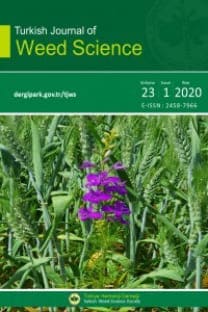KURAKLIK PERSICARIA PERFOLIATA'NIN TÜRKİYE'DEKİ İSTİLASINI DURDURABİLİR Mİ?
Dünya üzerinde istilacı bitki sayısındaki artış ekolojik ve ekonomik açıdan önemli sorunlar oluşturmaktadır. Bu bitkilerin başarılı bir şekilde kontrol altına alınabilmeleri için bunların biyolojik ve ekolojik isteklerinin bilinmesi büyük önem taşımaktadır. Bu bitkilerin yeni habitatları istila sürecinde, kuraklık ve tuzluluk gibi abiyotik stres koşulları bir bariyer işlevi görmektedir. Bu nedenle istilacı yabancı bitkilerin stres koşulları altında büyüme ve gelişme durumlarının belirlenmesi amacıyla yapılan çalışmalar bu bitkilerin biyolojik ve ekolojik isteklerinin anlaşılmasına ve potansiyel dağılım alanlarının modellenmesine olanak vermektedir. Persicaria perfoliata L. Doğu Karadeniz Bölge'sinin önemli bir kısmını işgal eden istilacı sarmaşık formunda tek yıllık bir istilacı yabancı ottur. Bitkinin yaygın olduğu Doğu Karadeniz sahili sahip olduğu 2000-2500 mm yıllık yağış miktar ile Türkiye'nin en fazla yağış alan bölgesidir. Bu ön çalışma ila P. perfoliata'nın Türkiye'nin diğer bölgelerine yayılma potansiyelinin anlaşılması amacıyla büyüme ve gelişme yönü ile kuraklık stresine verdiği tepkilerin belirlenmesi amaçlanmıştır. Kuraklık stresi tarla kapasitesi baz alınarak saksılardaki su oranının sınırlanmasıyla suretiyle oluşturulmuştur. Çalışma da %25, %50 ve %75 tarla kapasitesi ile kontrol (%100) olmak üzere dört farklı stres düzeyine yer vermiştir. Saksılarda tarla kapasitesi her gün buharlaşan su kadar saksılara yeninden su verilmesiyle sağlanmıştır. 28±3°C gündüz 16 saat ve 20±3°C gece 8 saat koşullarında denemeler yürütülmüştür. Omca uzunluğu, omca başına yaprak sayısı, yer üstü ve yer altı kısımların yaş ve kuru ağırlığı, kök uzunluğu, kök yaş ve kuru ağırlığı gibi parametreler incelenmiştir. Çalışma sonucunda kuraklık yoğunluğundaki artış ile incelenen bitki parametreleri arasında negatif ilişki saptanmıştır. %50 tarla kapasitesi uygulamasında ağırlık artışı gibi parametrelerde ciddi düşüş görülmüştür. Yabancı otları kuraklığa yüksek duyarlığı bu bitkilerin ülkede yayılmasında sınırlı bir faktör olduğunu göstermektedir. Yağışların fazla olduğu alanlarda ise yabancı ot istilası fazla olacaktır. Yarı kurak ve kurak alanlarda ise istilacı bitki sorun olmaktan çıkacaktır. Çalışmamızda iklim değişikliğinden meydana gelen kuraklığın bölgede ot yayılışını engelleyebildiği belirlenmiştir
Anahtar Kelimeler:
Persicaria perfoliata, Kuraklık, Biolojik istila, Karadeniz Bölge
CAN DROUGHT LIMIT THE FURTHER INVASION OF PERSICARIA PERFOLIATA IN TURKEY?
The increasing number of invasive plants throughout the world has been creating serious ecological and economical concerns. The knowledge of biological and ecological requirements of these plants is the key factor for their successful management. Abiotic stresses such as drought and salinity are the most important factors limiting the invasion of plants in new habitats. Therefore, growth and development studies of these invasive plants under stressful environments enable the ecologist to understand their biological and ecological characteristics and to model their potential distribution areas. Persicaria perfoliata L. is a troublesome invasive vine which has already invaded the considerable areas within the Eastern Black Sea region of Turkey. Eastern Black Sea coast is the rainiest region with 2000 to 2500 mm annual rainfall. Current study was a preliminary work to understand the growth and developmental responses of P. perfoliata L. under drought stress to predict the potential distribution areas in the other regions of Turkey. Drought was simulated by limiting the water supply to pots based on field capacity (FC). Three drought intensities (75%, 50% and 25% FC) along with a control (100% FC) were included in the experiment. The experiment was conducted in greenhouse under controlled conditions (28±3°C and 20±3°C day and night temperatures and 16 and 8 hours light and dark periods). The FC of the pots was maintained by adding the evaporated and consumed water every second day. At the later stage of the experiment, the pots were watered daily due to more plant height and transpiration. Data regarding vine length, number of leaves per vine, above and below ground fresh and dry biomasses, root length, root fresh and dry weight, number of seeds per vine etc. were collected at the end of experiment. The results indicated that increasing drought intensity negatively affected the growth and development attributes. Severe reductions in biomass production and reproductive output were observed beyond 50% of FC. The high sensitivity of plant to drought stress indicates that drought might be a limiting factor for the further spread of the plant in the arid and semi-arid regions of the country. The results of the study also indicated that the areas receiving high amount of rainfall will probably be pruned to severe invasion of the plant. It is predicted that the climate change induced forthcoming drought may limit the further spread of the plant while increasing rainfall may accelerate the invasion process of the plant in the country
Keywords:
Persicaria perfoliata, Drought stress, Plant invasion, Black sea region,
- ISSN: 1303-6491
- Başlangıç: 1998
- Yayıncı: Türkiye Herboloji Derneği
Sayıdaki Diğer Makaleler
ABUTILON THEOPHRASTI (MEDIK)’IN (İMAM PAMUĞU) TÜRKİYE’DE YAYILMASI
AMBROSIA ARTEMISIIFOLIA’NIN KARADENİZDEKİ MEVCUT DURUMU
Hüseyin ÖNEN, Nihat AKYOL, Hikmet GÜNAL
İzzet KADIOĞLU, Gizem DOĞAR, Ümmü CİĞER
KURAKLIK PERSICARIA PERFOLIATA'NIN TÜRKİYE'DEKİ İSTİLASINI DURDURABİLİR Mİ?
Hüseyin ÖNEN, Uğur ÇALDIRAN, Shahid FAROOQ, Cumali ÖZASLAN
İKİ İSTİLACI BİTKİNİN NORMAL VE DEĞİŞTİRİLMİŞ CO2 KONSANTRASYONLARI ALTINDA GELİŞİMLERİ
Khawar JABRAN, Mehmet Nedim DOĞAN
Avrupa Birliği İstilâcı Yabancı Türler Yasası
PHYSALIS PHILADELPHICA LAM.’NIN GÜNEYDOĞU ANADOLU BÖLGESİNDEKİ MEVCUT DURUMU
Cumali OZASLAN, Bekir BÜKÜN, Selçuk ÖZCAN, Hüseyin ÖNEN
